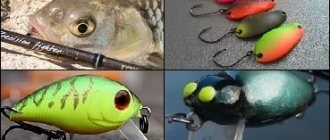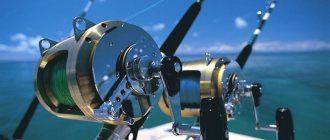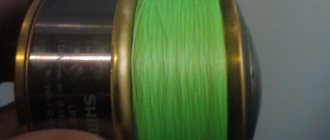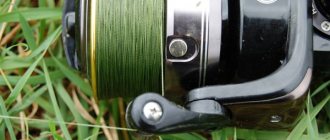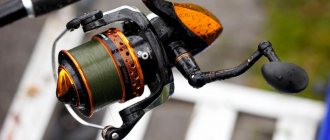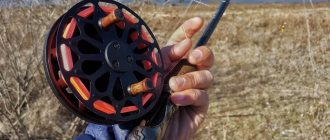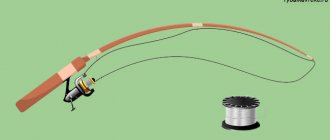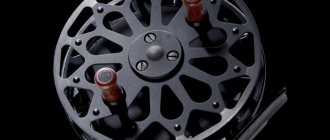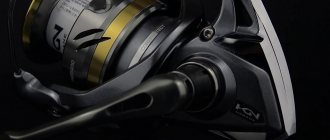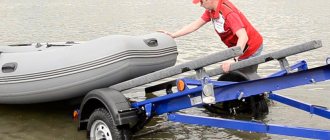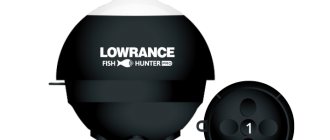What should you pay attention to when choosing a spinning reel?
- Smooth ride
- Coil size
- Spool (coating material, size, depth, shape)
- Comfort of the handle and its length
- Number of bearings
- Friction brake (sensitivity, location)
- Bayrunner (if required)
- Line laying quality (line laying roller)
- Overall body rigidity
- Permissible load on the friction brake.
Let's look at the presented parameters in more detail.
Smooth reel running
Smoothness is an extremely important parameter, since smoothness affects sensitivity and the uniformity of winding the line onto the spool. The smoothness of the reel is affected by the number and quality of internal bearings, the balance of the rotor, the rigidity of the housing and other elements of the mechanism.
A poorly wound line will cause the bait to twitch and also negatively affect the casting distance of the bait. And the process of exhausting itself will not be the most pleasant if the ride is poor.
It is worth noting that using too large weights when reeling in can speed up the wear of the internal parts of the reel, which will impair its smoothness.
Bobbin size
The size of the spool depends on the fishing method and the thickness of the fishing line. On reels you can find some values of 1000, 2000, 2500, 3000, 4000, 5000 and even 12000. The number 1000 shows that the spool can hold 100 meters of fishing line with a thickness of 0.1 mm, and the number 3000 can hold one hundred meters of fishing line with a thickness of 0.3 mm.
- For light spinning (ultralight), reels with 1000-2500 spools are usually used.
- For medium spinning rod: 2500-3500.
- For heavy spinning, 4000+ spools are used.
- For feeder fishing, use reels with 2500-5000 spools.
- For carp fishing 5000+.
The size and depth of the spool should be selected depending on the length and diameter of the fishing line you are using and the casting distance of the bait.
How to choose the right spinning reel?
To size
As noted above, in order to save money, some manufacturers produce a reel of the same size with different spool sizes: for example, a spinning reel, originally designed to be equipped with 2500 spools, is equipped with spools of sizes 1000, 1500 and 2000 and produces these three reels as reels of different sizes.
Therefore, when choosing a spinning reel, you should definitely pay attention not only to the indicated spool size, but also to the overall size of the device . Otherwise, you can find yourself in an unpleasant situation: for example, buy the above-described reel with a size 1000 spool, expecting to fish with ultralight. Naturally, since this spinning rod was created for a 2500 spool, it will actually turn out to be too large and will not be suitable for ultralight gear at all.
If when purchasing in a regular store it is very easy to estimate the size of the coil, then when purchasing online it is quite possible.
How to choose a reel for a spinning rod by weight (mass)
Since the spinning rod is constantly in the hands of the fisherman, the smaller the weight of the gear, the better. Therefore, other things being equal, it is worth choosing the lightest model if possible. But don’t forget that the spinning rod must be harmoniously combined with the fishing rod: if the blank is long and heavy, then, of course, you shouldn’t use a reel that is too light.
For ultralight
An inertia -free reel is the only type of reel that is suitable for ultralight fishing : neither a “classic” drum inertia reel nor a multiplier are suitable for casting light and ultra-light baits.
At the same time, finding a good reel for ultralight fishing at an affordable price is not at all easy - as a rule, such inertia-free reels are either very expensive or are of unsatisfactory quality. Therefore, anyone who decides to try ultralight should be prepared for the difficulties of choosing a worthy model.
A reel for ultra-light fishing is selected according to the size of the spool (usually no more than 1500-2000) and weight. The lighter the weight of such an inertia-free reel, the better; however, as in the case of reels of heavier classes, the reduction in weight should not come at the expense of strength and reliability.
For jerk wiring
One of the main requirements for a reel for fishing with twitching, ripping, jerking and other similar types of fishing is the ability to lay the line evenly , which goes in jerks. If the laying is poor, the casting distance will decrease and the possibility of beard formation will increase.
Without sufficient experience, it may not be so easy to determine on your own how well the reel reels in the line. In this case, you can use the advice of a competent sales consultant, more experienced friends, or a rating of fishing reels.
For jerking
Since jerk fishing involves moving large, heavy baits in a very aggressive manner, the tackle must be appropriate.
As for the reel (you can use either a multiplier or a spinning reel), it must be a truly powerful and reliable device made of durable materials.
Otherwise, the coil will become unusable quite quickly.
How to choose a reel for a fishing rod in a store
When choosing a reel in a store, you need to pay attention to several main points.
- No damage: the model you like must be carefully inspected for visible damage. Particular attention should be paid to moving parts - the line roller, handle and spool.
- Smoothness of the spool: Run your finger along the side of the spool to evaluate its smoothness. If even the slightest nicks are felt, you should not buy this copy.
- Operation of the line roller: it is necessary to move the line roller to the “cast” position and push it to the “rewind” position. If the video skips too easily, it means that while fishing this can happen at the most unexpected moment. You should not buy such a reel.
Spool cone shape and profile depth
Deep spools hold a larger amount of fishing line, the casting range with such spools is low, and are used for thick braided or monofilament fishing line.
Shallow Air Spool spools are mainly used for thin braided lines. Typically, such spools have an increased diameter.
Long Cast spools are commonly used on carp reels. The long cone-shaped spool provides good capacity and long casting.
There are also reverse taper spools that are used for spinning reels. The reverse cone eliminates loop shedding and reduces the risk of line tangling.
Spool material
The spool can be made of either plastic or metal.
It is better to avoid plastic spools, as they wear out quickly and have high friction. Braid on plastic spools will not be used.
Metal spools are usually made from aluminum, while more expensive ones are made from titanium or composites. There are also aluminum spools coated with titanium nitrite, which have a very smooth surface, wear resistance and strength.
Reels with titanium hard-coated aluminum spools are much more expensive than regular reels.
Line handle and roller
When the bow is folded back (when casting), the line comes off the spool; when the bail is closed, the line stops coming off. The line handle, roller and spool must be smooth and free of burrs.
The important thing is that the fishing line falls directly onto the special roller and does not get caught on anything.
Spinning reels - main characteristics
For each spinning direction, special requirements are imposed on the reels, which determine their ability to ensure 100% suitability of the gear for specific baits and equipment, their correct presentation, and the ability to catch fish in the given conditions.
The main parameters of any spinning reel are:
- size; - weight; – reduction; – type of friction brake; – line capacity of the spool.
Therefore, before choosing a reel for a specific fishing direction, you need to evaluate all the performance characteristics as a whole.
Spinner size
This indicator is perhaps the most important. The smallest coil is marked with the numbers “500”, the designation of the largest one can reach the value “20000”. In our conditions, it is customary for spinning anglers to use spinning rods ranging in size from 1000 to 6000:
1000 – 2000 – coils for ultralight; 1500 – 2500 – reels for light fishing; 2500 – 4000 – spinning rods for “adult” spinning rods; from 3500 – “heavy” and trophy fishing.
Naturally, the size range of coils from different manufacturers differs and does not correspond to each other. Therefore, it is customary to take products from the Japanese concern Shimano as a standard. This is a generally recognized leader in the fishing goods market.
Inertia-free or multiplier for ultralight - which reel is preferable? What type of reel – multiplier or spinning reel should you prefer for ultralight fishing? The question is not so simple, and the answer depends, among other things, on the experience of the fisherman and the time of use of this or that gear.
Coil gear ratio
The inertia-free reduction shows how many revolutions the spool makes with one full revolution of the handle.
According to this indicator, all “meat grinders” are divided into:
– power; – universal; – high-speed.
Power ones have a reduction from 3.2:1 to 4.6:1 . These are powerful “winches” capable of developing high traction force. They are used in heavy jigging, fishing with large and stubborn baits, trophy hunting, lake and river trolling.
Heavy jig reels >>
Inertia-free reels with gear ratios from 4.8:1 to 5.5:1 are considered universal reels. In terms of traction indicators they are inferior to power ones, but they are much more variable in terms of fishing techniques and the speed of feeding the bait.
They are in demand everywhere – from ultralight to all types of “adult” spinning rods.
“Meat grinders” with a reduction of 5.5:1 are called high-speed . They are used in light spinning rods with small baits and when hunting small fish that do not offer decent resistance. Suitable for catching trout, grayling, perch, chub, rudd and other white representatives of the ichthyofauna.
Weight of spinning reel
The weight of a spinning reel is no less significant than those described above. Correctly selected reel weight will ensure the overall harmony of the gear. An imbalance, on the contrary, will lead to the fact that the fishing rod will either “peck” at the tip or tip over. As a result, the angler will not be able to fully perform the retrieve and control the behavior of the bait; it will be difficult for him to fish all day without getting tired of the constant need to balance the spinning rod with his hand.
Ultralight coils weigh about 200 grams.
In “adult” spinning rods, models are used whose weight reaches 250–400 grams.
When fishing with heavy baits and hunting trophy underwater inhabitants, this characteristic can reach 500–600 and even 700 grams.
Friction brake
Friction is an important part of any inertia-free system. It is this that prevents the line from breaking when the loads become critical. A good, sensitive braking mechanism will release the thread from the spool in the event of sudden jerks of the predator or a sudden snag on an underwater obstacle.
There are two types of friction mechanism: front and rear.
The majority of spinning reels have a front drag. It is located on the spool, which allows you to reduce the size and weight of the spinning machine. For most people, this brake location is more convenient.
Rear drag is more common on feeder and match reels. It is generally accepted that it is more subtle in adjustment, but not as comfortable as the front one.
Friction clutch
An element of a spinning reel that allows you to release the cord or line when reeling in a fish so as not to tear the line or the fish’s lip. With strong jerks, you need to let the fish unwind the line from the reel, as the fish gets tired and cannot break the line. The clutch can be rear or front.
For spinning, reels with a front drag are usually used.
For feeder or carp fishing, reels with a rear drag and a baitrunner are used.
The front clutch is considered more sensitive and more reliable and is more finely adjusted.
Coil gear ratio - what is it?
The gear of a fishing reel is the ratio of how many revolutions the spool makes when the handle is turned 360 degrees. It doesn’t matter whether it’s a baitcasting reel or a spinning reel. The characteristic is indicated in numbers separated by a colon.
For example, for Riobi Exiya 3000 “4.9:1” means that for one full revolution of the reel handle the spool makes 4.9 revolutions. Sokol has 7.1.
The range of revolutions for different reels can vary from 1 to 9. In the first case, this applies to fly fishing reels.
Some manufacturers classify reels into "low gear", "high gear" and "extra high gear". In this case, instead of numbers separated by a colon there is a letter designation - PG, P, HG, H, XG. However, there are no specific standards and each company uses its own. For example, Daiwa “scattered” its standards as follows:
- P (slow, power) - 4.9 or less.
- NG (average rotation speed) - 5.0-5.4.
- H (high speed) - 5.5-5.9.
- XH (extra high speed) - 6.0 or more.
Shimano use theirs.
What is important for us to understand from these notations? According to mechanics, the lower the gear ratio of the reel, the more powerful it is positioned. This is, firstly. Secondly, the more revolutions the spool makes per rotation of the handle, the higher the speed of the bait. Therefore, the distance it travels is greater.
It is impossible to say exactly how much fishing line is reeled out per rotation. In most cases, this is determined only by your own measurements. It is impossible to talk about any specific numbers. Reels of different sizes will wind different amounts of line per revolution. At the same time, have one gear ratio. For example:
- 1000 4.6: 1 - 56 cm.
- 2500 4.6: 1 - 65 cm.
- 4000 4.6: 1 - 72 cm.
And how should this help us in choosing a reel?
Spinning reels for fishing (video)
We also recommend that you read reviews/feedback about the following reels:
- Daiwa Luvias review and reviews
- Daiwa Certificate
- Daiwa laguna
- Daiwa Sweepfire
- Daiwa Revros
- Daiwa Crossfire
- Daiwa Freams
- Daiwa Exist
- Daiwa Caldia
- Daiwa Crest
- Daiwa Exceler
- Shimano Biomaster FB
Daiwa Certificate
Shimano Twin Power
Daiwa Luvias 12
Daiwa Freams
Daiwa Crossfire
Daiwa Exceller
Daiwa Legalis
Daiwa Laguna
Daiwa Crest
Daiwa Revros
Daiwa Sweepfire
Bayrunner
A baitrunner is a special mechanism for releasing a fishing line or cord. That is, when the baitrunner bracket is pulled back, the reel spool begins to bleed out the line, and when you press the bracket back, the spool stops bleeding out the line, which is very convenient.
Baitrunner is most often used in carp and feeder fishing.
The baitrunner can also be used as a bite alarm, since during the jerk the fish will pull the line from the reel, which will be accompanied by a characteristic crack that can be heard ten to twenty meters away.
Friction system
Almost all spinning rods are equipped with a friction brake, but it is not always in demand among fishermen. This element is used when catching very large fish, which are not always possible to catch. It will also help out with strong jerks - a reel with a good brake releases the line evenly.
A distinction is made between front and rear brakes. The front friction brake is more sensitive and smoother, and the rear one is more convenient, it is easier to adjust and, in case of failure, to repair or replace with a new one, along with the spool.
Here you probably need to rely on the fact that reels with a front brake are more compact, which is good when walking for many hours while fishing. They have wider brake discs, which makes them act faster. The smoothest movement and fine adjustment.
Reel weight
In most cases, the lightness of the reel is an advantage for the angler; a light reel gives greater convenience and freedom of action, and you will be less tired with a light reel.
On the other hand, saving on the materials of the reel parts, which should be made of metal, increases the weight of the reel. Therefore, it is worth looking for some balance and knowing that the reliability and durability of the reel is still more important than its lightness.
In other words, the heavier the spinning reel, the more reliable it is, but not always. The most modern reels can be made from composite materials, which are both stronger and lighter than aluminum, but they are much more expensive.
The weight of the reel plays an important role in the overall balance of the tackle. The balance of the tackle is the correct center of gravity of the rod and reel; the closer it is to the reel handle, the better. This balance puts less strain on the hand and allows for more efficient wiring.
Particularly light reels are important in ultralight, when the spinning rod itself and baits are as light as possible. The average weight of ultralight reels is 200-260 grams.
Aluminum housings of spinning reels are less deformed under loads, which increases their service life.
Types of spinning reels
Technically, the term “spinning reel” applies only to spinning reels—“meat grinders.” Inertial reels, although they can be installed on a spinning rod, are now almost never fished with archaic inertial reels like “Nevsky” ones, and for modern multiplier inertial reels there is a separate class of rods - casting rods, which have a special finger trigger and a special ring design. You can read more about them in this article.
Spinning reels
Most fishermen use the term “spinning reel” to mean spinning reels. Having appeared at the end of the 19th century, spinning reels gained enormous popularity, first in Europe, and then throughout the world, with the exception of the United States, where at that time a long-standing culture of using multipliers had already developed.
Inertia-free casters are easy to maintain and inexpensive, and their most outstanding quality is their long casting range and ease of casting, as well as effective work with small baits and thin tackle. Further in the article we will talk specifically about the choice of inertia-free coils.
You can read about other types of reels that you can install on a spinning rod at the end of the article.
Cloudflare Ray ID: 63aa4562787d1d06 • Your IP: 195.64.208.251 • Performance & security by Cloudflare
2. A spinning reel should lay the line very evenly on the spool. There are 3 types of winding:
1. Correct spinning reel size. All models of spinning reels have their own classification and are divided by spool volume:
- 1000;
- 1500;
- 2000;
- 3000;
- 4000, etc.
For example, a spool with a size of 2000 tells us that it holds 100 meters of fishing line with a diameter of 0.2 mm. A reel with a spool, the volume of which is 1000, holds 100 meters of 0.1 fishing line. At the beginning of the guide, we gave advice to look towards 1500-2500, no more.
2. A spinning reel should lay the line very evenly on the spool. There are 3 types of winding:
- cylindrical;
- reverse cone;
- straight cone.
Regardless of what the winding cone is, the line should not lie wavy on the spool. The line from the board should be straight. In the case of cylindrical winding, this line will be straight and parallel to the bobbin; in the case of reverse or straight cones, the line will also be straight, but at a slight angle to the bobbin.
Such a spool does not allow the braid to fly off the reel too much due to inertia, which prevents tangling.
The casting reel has a spool with a small margin for winding line, this allows you to make long casts and wind the line evenly
3. For beginners, a casting spinning reel is best suited. It differs from the usual one in that its spool has a very small reserve for winding fishing line, but this reserve is quite enough to wind 70-80 meters of fishing line. The advantage is more uniform winding.
Do not wind the line onto the reel to the very edges (to avoid beards and tangles), especially if you are using rigid monofilament or soft braid. An exception can be made for very soft monofilament fishing line and hard braid. Although it is still advisable to leave 1 mm from the edge of the side, and with experience you will understand whether it is possible to increase the amount of fishing line on the spool to the very edges, or whether this should not be done.
4. The reel should move easily. It should not crunch, the parts should not touch each other. The more the reel rotates after a short jerk of the reel handle, the better.
6. The number of ball bearings in the reel is not critical. Yes, this is indeed true, but under one condition, if there are at least 4 ball bearings, all the rest are secondary ball bearings and this quantity does not affect the elite quality of the product in any way. Now even the worst Chinese spinning reels can have up to 10-12 ball bearings.
The line roller must rotate, otherwise sooner or later it will begin to wear out and spoil the line. Its design must have a ball bearing
7. Choose branded reels. Even Shimano and Daiwa have reels in an affordable price range for almost any angler, and they will last much longer than any Chinese product.
8. Friction brake. It is difficult to find a spinning reel that does not have a friction brake. But this part of the coil is made in different coils of two types:
- front friction brake (on the front of the spool there is a relief notch or other relief notches, by which this round clutch can be rotated in one direction or the other);
- rear clutch (there is a handle at the back of the reel; by turning the handle you can loosen it and vice versa make the clutch tighter).
[rs2]
The rear friction brake has a more complex mechanism, makes the reel heavier and, in general, reels with such a brake are larger, and it is also considered less sensitive than the front one. But in contrast to the disadvantages, it also has advantages: when playing fish, it is much easier to adjust, unlike the front clutch, and the spool of the reel, which has a clutch at the back, is easily changed and replaced with another spool (for example, with a different type of fishing line) .
The front drag is more sensitive, the reel weighs less, but adjusting the drag while fishing is more difficult than using the rear brake. And yet, we will give preference to the front clutch, it makes the tackle lighter and is sensitive.
There are as many as 3 washers for adjusting the line winding cone; if there are no washers, this is a minus
A reel with a good friction brake should not release line jerkily. If you pull the line from the spool with a uniform movement of your hand, then the clutch should evenly release the line.
9. Check the presence of a rubber gasket (washer) on the spool axle. A larger number of such gaskets may be included with the reel, for example 3, as in the figure on the right. Their direct purpose is to regulate the winding of the fishing line on the reel. By inserting and removing such washers, you can adjust the winding of the fishing line with a reverse and forward cone.
10. The line roller of the spinning reel must rotate. Otherwise, especially if you use a braided fishing line, it will wear out, a slot will appear, the fishing line will go into it, get dirty, and one day it will just get stuck there and the reel will have to be changed.
The design of this roller must have a ball bearing.
11. Ignore the gear ratio on the reel. This is the number of spool revolutions that the reel will make during one revolution of the handle. If you are a beginner, but this indicator is not important to you yet. Advanced fishermen already have an idea of whether they need a faster reel stroke than they have, or whether the existing one is enough. Without experience, you will not be able to determine the correct gear ratio for your fishing technique.
12. You need to choose a reel for your spinning rod. If it is an ultralight, then take a smaller coil (up to 1500). If jig, then 3000. Pay attention to the weight of the reel when comparing it with your spinning rod.
How to choose a spinning rod - a guide to one of the most multifunctional lines of spinning rods, jig tackle, will tell you.
Guide to choosing telescopic spinning rods - test, length, action and other important parameters.
Ultralight reels - a guide to choosing ultralight spinning tackle.
- 750 – 2000 (15-20) – light class, recommended weight of baits up to 14 g.
- 2000 – 3500 (20-35) – middle class, respectively, the weight of the bait is 15 – 35 g.
- 4000 – 5000 – heavy class.
A spinning rod and reel are selected as a complete set for the existing fishing conditions, and first of all, for the weight of the baits that will be used. It is absolutely wrong to buy and install a high-power reel on an ultralight rod, or vice versa. When choosing a spinning reel, you need to take into account a number of characteristics of this device, first of all, pay attention to the size.
There is a recommended relationship between the size of the reel and the weight of the baits used. The larger size is suitable for larger bait weights.
Reel size and bait weight
The problem is that each company characterizes the size of the coils with its own classification, with Japanese manufacturers indicating the size in thousands - 1500, 2000, 2500... etc., and European manufacturers in tens - 20, 25, 30.... But the dependence is this: the larger the number (the larger the size), the heavier class of rods and baits this reel corresponds to.
These numbers roughly mean the following:
- 750 – 2000 (15-20) – light class, recommended weight of baits up to 14 g.
- 2000 – 3500 (20-35) – middle class, respectively, the weight of the bait is 15 – 35 g.
- 4000 – 5000 – heavy class.
Medium universal options
- If you exceed the recommended weight of the lures, the reel will quickly become loose from excessive loads and may fail prematurely.
- If a large and powerful reel is used with small weights, the sensitivity of the entire tackle will be lost, and the spinning rod will simply become rough.
Accordingly, the average option “for all cases” can be considered a regular spinning reel with a dimension of 2500 – 3000 (25 – 30). For beginner fishermen, it is recommended to buy a spinning reel with the specified characteristics, for the corresponding rod test (maximum weight of the bait used) - 20 - 30 grams.
Special designs
Also, from the whole variety of spinning reels, we can distinguish special designs intended only for certain fishing conditions.
- Ultralight reels. They are designed to work with baits weighing only up to 14 grams. Their main advantage is their low dead weight and a precisely calibrated mechanism for thin fishing line, which is achieved by using expensive light alloys. Their price is significantly higher than usual. But using heavier baits with them, or those that have increased resistance in the water, is not recommended in order to avoid failure.
- High power products. Designed primarily for heavy jigs (up to 50 g), used in the current. Their dimensions are also large - at least 3000, and additional bearings are introduced into the mechanism.
- Usually, if the weight of the bait exceeds 50 grams, then it is worth thinking about a multiplier, because inertia-free (meat grinders) with such weights already lose their advantage in casting range and ease of control, and the fragility of their fundamental design begins to affect.
Division of coils by gear ratio
It remains to add that inertia-free coils are conventionally divided according to the gear ratio:
You can select spinning reels according to the following table:
Coil load
Regarding the load, it is only worth noting that the larger the reel, the larger its internal parts, and as a result, in theory, it should withstand heavy loads and be able to install large spools. This is why carp reels are made so large.
The load on the friction brake is also affected by the gear ratio of the spinning coil. The lower the number, the more powerful the traction coil.
Example: a reel with a gear ratio of 4:1 will be more powerful than a similar reel with a gear ratio of 5.5:1.
Basic parameters when choosing a spinning reel
Materials used in reels
The main materials used in the manufacture of spinning reels are metal and plastic. Moreover, there are hundreds of varieties of both the first and second materials, differing in their performance properties. Very often, combinations of these materials are used in reels. For example, the body is made of durable plastic or light metal alloys such as titanium or duralumin, the spool is made of aluminum alloys or plastic. The line handle is made of composite materials or stainless steel, etc. Despite the fact that various materials are used in reels, there are models where only plastic or only metal is used. The durability of all-metal reels is much higher, but they lose sensitivity when biting, and also cost much more than their competitors.
By improving the technical characteristics of reels, manufacturers are constantly updating their model line. Achieving greater strength in structural units, manufacturers are trying to reduce the weight of the structure. The cost of such reels is not small, but it justifies itself when fighting fish. The most common reels are those with a carbon fiber body due to their strength and relatively low price. It must be said that modern carbon fiber is in many ways superior to various types of metals.
When choosing a spinning reel, you should not blindly succumb to the principle that the more expensive the better, you should read what materials it is made of, and only then make a purchasing decision. Although, as practice shows, the price directly depends on the quality of the fishing reel.
Gear ratio of spinning reel
The gear ratio of a spinning reel is the ratio of one full revolution of the handle to the number of revolutions of the line guide. Based on this definition, all coils can be divided into 2 types:
- power
- expressways
The ratio of these revolutions is indicated directly on the reel in the form of 5.0:1 or 5.3:1 - this means that one revolution of the reel handle corresponds to 5 (5.3) revolutions of the line guide. The higher the first value, the faster the coil is and vice versa, if this value is lower, then the coil is more powerful.
Reels with a gear ratio of 5.0 or less are usually called power, and those with a gear ratio greater than 5.0 are called high-speed.
The value of these coefficients depends on the pitch of the gear teeth. In simple terms, power reels are designed for catching large fish, such as catfish or a number of other marine fish, and high-speed ones are for more delicate fishing, for example, with jig baits or small wobblers.
A ratio of 5.0 is the golden mean between these reels, so if you don't know what kind of fish you'll be catching tomorrow, opt for versatility.
Reel handles
Handles come in the following types:
- screw-in
- screw fastening
- with rivet.
There are no particular differences in operation between the types of fastening, but the handle itself should be comfortable and reliable. Preference is given to handles made of metal or hard plastic that are rubberized and without significant play and do not bend under load.
When choosing a spinning reel, pay attention to the play of the handle; the smaller the play, the better.
Spinning reel bearings
It is worth noting here that the more there are, the better, since the reel parts will have less friction and, accordingly, will be more durable. And overall the reel will be smoother and more enjoyable.
Reel bearings vary in quality and shape. There are ball and roller bearings. Roller bearings are considered more efficient.
Here are the main parameters of the coils that you need to pay attention to. When comparing similar reels, you should give preference to reels from Daiwa, Shimano and Ryobi, as they have long been considered among the highest quality and most reliable.
